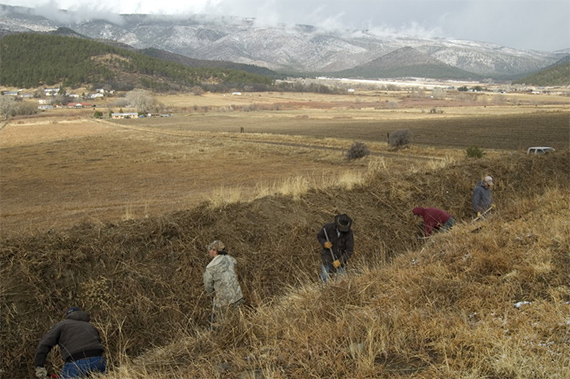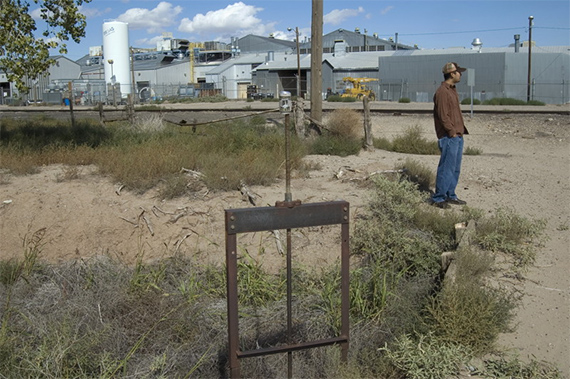Page 3
IV. Culturally specific ways of viewing water sharing and water value
Basically, New Mexico is one of the few states that has a number of sustainable traditional alternatives to the water wasting ways of major cities. To summarize the nature of these alternatives in the briefest terms, both Native American and Acequia views of water are collaborative, cooperative, and communal in the sense that water is the fundamental resource for every human being. Water is not a commodity, not something you can sell and own. And although the New Mexico Constitution in Article XVI confirms that “the unappropriated water of every natural stream, perennial or torrential…is hereby declared to belong to the public….” non-traditional water users, usually junior rights holders, like cities, have a competitive, non-cooperative, marketplace financial attitude about water that is completely at odds with traditional views. The competitive view allows cities to get water where they can buy it, rather than live within their water means. And cities often buy it from financially trouble agrarian communities. Cities are so overgrown and overpopulated that there’s simply not enough water to feed their craving for growth, and maintain traditional cultures, conserve essential ecosystems, and expand our agricultural base to begin feeding ourselves from the toil and produce of local growers.
 (On Ditch Day in Guadalupita, near Mora, community members clear the acequias of winter debris to prepare for spring irrigation.)
(On Ditch Day in Guadalupita, near Mora, community members clear the acequias of winter debris to prepare for spring irrigation.)
V. New Mexico’s dams and waterworks as a microcosm those in other states in the West
New Mexico’s waterways are tied together by a series of dams and conveyances, some of which are in terrible states of disrepair. According to the 2009 Report Card for America’s Infrastructure, of New Mexico’s 398 dams, 181 of them of are “high hazard dams,” or one “whose failure could cause a loss of life and significant property damage.” The Report Card also contends that the state’s “drinking water infrastructure needs an investment of $922 million over the next 20 years.”
We depend on those dams for our very existence. From the flood control dam along the Rio Grande that makes Cochiti Lake to the essential storage lakes and dams at Heron, El Vado, and Abiquiu to the giant dam that creates the great, if drastically shrinking, reservoir of Elephant Butte Lake, our drinking water, manufacturing water, and agricultural water all depend on these highly engineered artificial systems. The San Juan Chama drinking water project depends on water stored at Heron Lake, water that moves from southern Colorado by means of small diversion dams, large tunnels, the Oso and Little Oso Tunnels and the Azotea Tunnel, and the sizable Blanco Diversion dam. Something goes wrong with them, and we lose what little Colorado River water we get – a minimum of 86,210 acre feet a year. In the past there had been a surplus to pass on, but with the drought that surplus has gone.
VI. The location and severity of groundwater and surface water pollution and the impact it might have on the quantity of usable water
In a serious, and possibly epic drought of many decades duration, and an ever drying normal climate brought about by global warming, to insure the drinkability of existing water supplies is as crucial as winning water wars against predator neighboring states. The study of water pollution is never something the general public, or politicians, really want to engage in.
But considering that the Air Force leaked 24 million gallons of jet fuel into Albuquerque’s aquifer in the northeast heights (possibly the largest such spill at America’s notoriously polluted Air Force bases), and that Sandia Labs has been dumping untold millions of gallons of military and industrial waste into Tijeras Arroyo, and that ground water in Albuquerque’s South Valley is among the dirtiest in the state, and that hundreds upon hundreds of uranium mill tailings are leaching and running off into groundwater west of Albuquerque, and that Santa Fe’s water supply has shown traces of plutonium from decades of dumping in canyons by Los Alamos National Laboratories (to name but the most spectacular polluters), it’s about time voters and elected officials start taking water pollution seriously. We need, obviously, all the clean water we have in this dry as dust state of ours.
 (Julio Dominguez of South Valley Partners points out a dead acequia across the railroad tracks from the GE plant. He says that these used to be irrigated lands but now they are junk lots: the water was polluted both by GE and by creosote pits used for soaking railroad ties. The acequia was shut down.)
(Julio Dominguez of South Valley Partners points out a dead acequia across the railroad tracks from the GE plant. He says that these used to be irrigated lands but now they are junk lots: the water was polluted both by GE and by creosote pits used for soaking railroad ties. The acequia was shut down.)
VII. The condition of public discourse on water issues
We have excellent environmental writers in New Mexico -- Laura Paskus, Staci Matlock and John Fleck chief among them -- but the level of public knowledge and discourse about water is not high. In fact, except for what some call “Water World” folks, those hard working, public spirited people who make up regional planning groups like the Water Assembly, and statewide water planning groups like the New Mexico Water Dialogue, discussion of how to adapt our cities and our agriculture to drought and climate change is almost non-existent in the public media, and even in the legislature. And the Governor, the mayors of major cities, and various elected water authorities sing to the choir or not at all. The New Mexico Mercury hopes to help break this dangerous silence.
The above seven parts of the whole water picture are necessarily over simplified here. I’m sure there will be better organized views of the myriad parts of the whole water system in the future. A holistic approach to water-thinking is crucial for clarity and practicality. But the complications are daunting. If this preliminary picture of our water system was mapped, each state, each river complex, each aquifer and city and agricultural area, each plume of pollution, each climate situation would be connected by a tangle of lines and arrows. I’m not sure if mapping would give even an approximate model of the whole. Perhaps a hologram would do it.
In systems thinking, the whole is greater than the sum of its parts. And the whole itself influences each of the parts in specific ways much as they influence each other. As I’ve said earlier, the whole water system in the West and in New Mexico has been destabilized by drought and has begun to wobble dangerously. This causes a kind of wooziness in its constituent parts which is unsettling everyone.
From what I can see, this whole picture tells New Mexicans that they are living beyond their water means, that hungry states with deep pockets, like Texas and California and Arizona and Nevada are perched to try to take as much water away from us as they can get away with, that we are precariously disabled by our lack of knowledge about how much water we actually have and how much we actually use, and that the old rural/urban conflict in New Mexico has made us weak and easy prey for the sharks that are circling us sensing vulnerability.
For New Mexico to get its water house in order, we need to do some of the following fast:
• Tax ourselves to build a water war chest that would give us a fighting chance in legal battles with stupendously rich states like Texas and California.
• Fund the state’s universities to conduct serious and sustained geological and hydrologic examinations of all of our aquifers and watersheds and to put in place serious conservation programs.
• Require monitoring of all well in the state.
• Appropriate funds to subsidize urban conservation infrastructure that replaces ancient and damaged water pipes and other technology.
• Appropriate funds to subsidize the creation of urban gray water and black water treatment and recycling systems, on an individual scale and on a city-wide scale.
• Adjudicate all senior water rights so we are in compliance with the New Mexico Constitution and have some way of analyzing water use and, more important, water overuse.
• Require by state law that cities grow within their water means, and help them to do that by subsidizing conservation infrastructure.
• Do away with laws and customs that promote the commodification of water and the purchasing of water rights, return flow credits, and similar devices.
• Do away with “dedications” that allow developers to merely promise the acquisition of water before they build their projects.
Many of these suggestions would result in cities with receding edges, serious infill redevelopment and retrofitting, and might usher in a new era of intelligent and responsible growth in quality of life and the businesses that support it.




Responses to “A systems approach to understanding water in New Mexico”